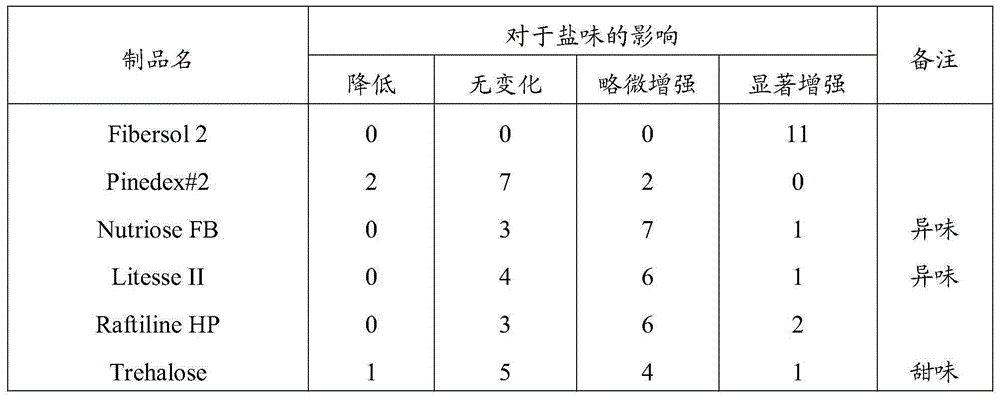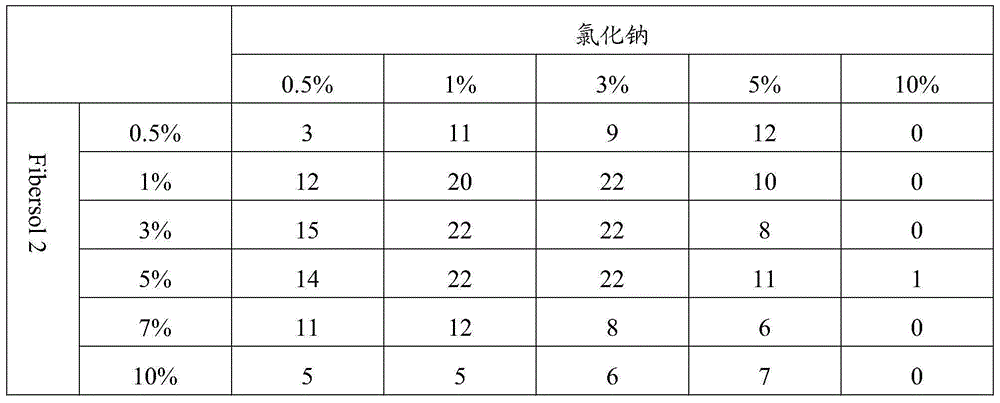Method for improving salty taste of food, food and drink and agent for improving salty taste
A technology of diet and salt taste, which is applied in the field of salt taste improver and potassium salt to food and drink. It can solve the problems that food manufacturers and consumers are unacceptable, poor versatility, etc., and achieve good taste balance, Reduce the risk of onset and deterioration, and improve the effect of bitterness and astringency
- Summary
- Abstract
- Description
- Claims
- Application Information
AI Technical Summary
Problems solved by technology
Method used
Image
Examples
experiment example 1
[0075]
[0076] The salty taste of sodium chloride is investigated how it is affected by the difference of coexisting water-soluble dietary fibers. As sodium chloride, reagent-grade sodium chloride was used, and as water-soluble dietary fibers, indigestible dextrin (marketed by Matsutani Chemical Industry Co., Ltd., trade name "Fibersol 2", molecular weight about 1600), branched maltodextrin ( Roquette, trade name "NutrioseFB", molecular weight about 1600), polydextrose (Danisco Cultor company, trade name "Litesse II", molecular weight about 2000), inulin (Dai Nippon Meiji Sugar Co., Ltd., trade name RaftilineHP, Molecular weight is about 1500). As a comparison, general dextrin (sold by Matsutani Chemical Industry Co., Ltd., trade name "Pinedex#2", DE10, molecular weight about 1700) was used, and trehalose (Hayashibara Co., Ltd. Ltd., trade name "Treha (Trehalose)").
[0077]
[0078] So that sodium chloride is calculated as 1.5% in dry weight conversion, and any one of ...
experiment example 2
[0084]
[0085] Since it was found that indigestible dextrin has the most salty taste enhancement effect among the dietary fibers used in Experimental Example 1, the relationship between the concentration of sodium chloride administered and the concentration of indigestible dextrin for the enhancement of salty taste was investigated. relation. According to the method of Experimental Example 1, sodium chloride and indigestible dextrin were dissolved and coexisted so as to be 0.5% to 10%, respectively, as shown in Table 2, to prepare a test aqueous solution. As a control, an aqueous solution containing 0.5% to 10% of sodium chloride without adding indigestible dextrin was prepared, and the salty taste of each test aqueous solution was compared by a tasting test. There were 11 sensory inspectors, including 6 males and 5 females, and judged at a room temperature of 26°C. Judgment is based on 4 stages of decrease (-1), no change (0), slight enhancement (1), and significant enhan...
experiment example 3
[0090]
[0091] Next, the effect of enhancing salty taste and the effect of improving (masking) off-flavor (bitterness) of water-soluble dietary fiber in the presence of sodium chloride and potassium chloride, which can also be called a representative salt substitute, were investigated. An aqueous solution in which 0.75% of sodium chloride and 0.75% of potassium chloride (reagent) were coexisted in dry weight conversion was prepared. Following Experimental Example 1, the salty taste and bitter taste and contrast (0.75% sodium chloride+0.75% potassium chloride without adding water-soluble dietary fiber) aqueous solution) compared to how it changes. There were 11 sensory inspectors, including 6 males and 5 females, and judged at a room temperature of 26°C.
[0092] The effects on salty taste and bitterness and astringency were judged in 5 stages of significantly lowered, slightly lowered, unchanged, slightly enhanced, and significantly enhanced compared with the control. Tab...
PUM
 Login to View More
Login to View More Abstract
Description
Claims
Application Information
 Login to View More
Login to View More - R&D Engineer
- R&D Manager
- IP Professional
- Industry Leading Data Capabilities
- Powerful AI technology
- Patent DNA Extraction
Browse by: Latest US Patents, China's latest patents, Technical Efficacy Thesaurus, Application Domain, Technology Topic, Popular Technical Reports.
© 2024 PatSnap. All rights reserved.Legal|Privacy policy|Modern Slavery Act Transparency Statement|Sitemap|About US| Contact US: help@patsnap.com










